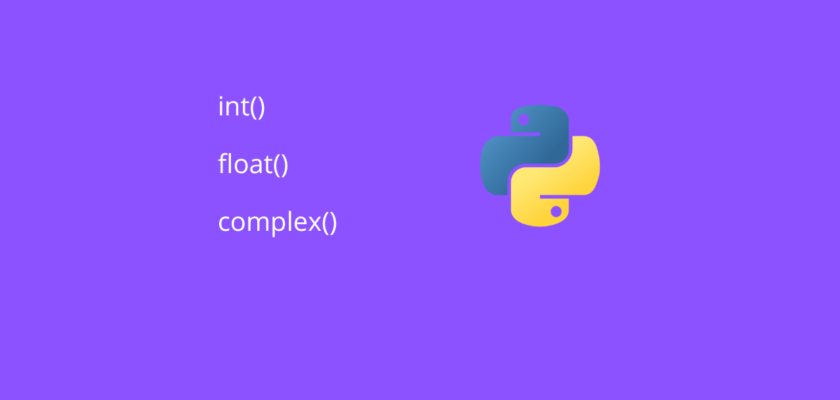In this article we will explore Python numeric data types.
Table of Contents
- Introduction
- Integers
- Floating point numbers
- Complex numbers
- Numeric operations in Python
- Examples
- Conclusion
Introduction
In Python, there are three distinct numeric types: integers, floating point numbers, and complex numbers. And numbers are created by numeric literals or as the result of built-in functions and operators.
Learning data types in each programming language is essential to understand the code and programs.
Numeric data types are widely used in many mathematical, statistical, data science, and machine learning solutions built in Python.
Python int (integer) numeric type
Python int (integer) numeric type represents an integer which is a whole number, it can be positive or negative, and it can be of unlimited length.
The int() constructor can be used to create an integer number in Python.
Consider the following examples:
a = 1
b = -2
c = int(5)
d = int('6')
print(type(a))
print(type(b))
print(type(c))
print(type(d))
print(a, b, c, d)
Output:
class 'int'
class 'int'
class 'int'
class 'int'
1 -2 5 6
Python float (floating point number) numeric type
Python float (floating point number) numeric type represents a number that contains one or more decimals, it can be positive or negative (including infinity).
The float() constructor can be used to create a floating point number in Python.
Consider the following examples:
a = 1.0
b = -1.10
c = float('5.5')
d = float('-inf')
print(type(a))
print(type(b))
print(type(c))
print(type(d))
print(a, b, c, d)
Output:
class 'float'
class 'float'
class 'float'
class 'float'
1.0 -1.10 5.5 -inf
Python complex (complex number) numeric type
Python complex (complex number) numeric type represents a complex number that contains one real and one imaginary parts, and is constructed from two real numbers.
The complex() constructor can be used to create a complex number in Python.
Consider the following examples:
a = 1+3j
b = -2+5j
c = complex(3,-7)
d = complex('1')
print(type(a))
print(type(b))
print(type(c))
print(type(d))
print(a, b, c, d)
Output:
class 'complex'
class 'complex'
class 'complex'
class 'complex'
(1+3j) (-2+5j) (3-7j) (1+0j)
Numeric operations in Python
All numeric types support the following operations:
| Operation | Result | int | float | complex |
x + y | Sum of x and y | ✔ | ✔ | ✔ |
x - y | Difference of x and y | ✔ | ✔ | ✔ |
x * y | Product of x and y | ✔ | ✔ | ✔ |
x / y | Quotient of x and y | ✔ | ✔ | ✔ |
x // y | Floored quotient of x and y | ✔ | ✔ | |
x % y | Remainder of x / y | ✔ | ✔ | |
-x | x negated | ✔ | ✔ | ✔ |
+x | x unchanged | ✔ | ✔ | ✔ |
abs(x) | Absolute value of magnitude of x | ✔ | ✔ | ✔ |
int(x) | x converted to integer | ✔ | ✔ | |
float(x) | x converted to floating point | ✔ | ✔ | |
complex(re, im) | A complex number with real part re and imaginary part im | ✔ | ✔ | ✔ |
c.conjugate() | Conjugate of the complex number c | ✔ | ||
divmod(x, y) | The pair (x // y, x % y) | ✔ | ✔ | |
pow(x, y) | x to the power y | ✔ | ✔ | ✔ |
x ** y | x to the power y | ✔ | ✔ | ✔ |
Examples
Knowing numeric data types and their properties is essential for operations.
Addition operation
Performing addition of integers will result in integer type output:
a = 1
b = 2
c = a+b
print(c)
and you should get:
3Performing addition of integer and float will result in float type output:
a = 1
b = 2.0
c = a+b
print(c)
and you should get:
3.0Subtraction operation
Similar to addition operation, performing subtraction of integer from integer will result in integer type output:
a = 5
b = 3
c = a-b
print(c)
and you should get:
2and performing subtraction of float from integer will result in float type output:
a = 5
b = 3.0
c = a-b
print(c)
and you should get:
2.0You can also subtract a negative number which will result in an addition operation:
a = 3
b = -6
#Operation: 3 - (-6)
c = a-b
print(c)
and you should get:
9Multiplication operation
Performing multiplication of integers will result in integer type output:
a = 5
b = 2
c = a*b
print(c)
and you should get:
10Performing multiplication of integer by float will result in float type output:
a = 5
b = 2.0
c = a*b
print(c)
and you should get:
10.0Division operation
Performing division of integers will result in float type output:
a = 9
b = 3
c = a/b
print(c)
and you should get:
3.0Performing division of integer by float will result in float type output:
a = 9
b = 3.0
c = a/b
print(c)
and you should get:
3.0Conclusion
In this article we explored Python numeric data types including integers, floating point numbers, and complex numbers.
As your next step in learning Python consider reading about Python data structures in the following articles:
